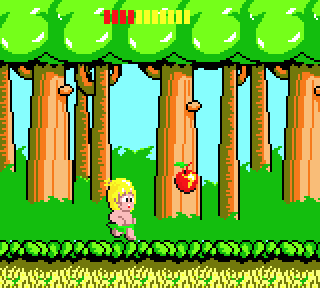|
Wonder Boy is a 1986 video game published by Sega and developed by Escape (now known as WestOne Bit Entertainment). It was the first in a long-running series of games and was followed up by five sequels, Wonder Boy in Monster Land, Wonder Boy III: Monster Lair, Wonder Boy III: The Dragon's Trap, Wonder Boy in Monster World and Monster World IV. The game was originally designed for arcades and was later ported to the SG-1000, Sega Mark III/Master System and the Game Gear by Sega, and to the ZX Spectrum, Commodore 64 and Amstrad CPC by Activision.
The 'Wonder Boy' in question is a nameless character (called 'Tom-Tom' in most localizations) – a tribal caveman-like boy whose girlfriend by the name of 'Tina' (renamed 'Tanya' in certain ports) has been captured by the dark King (sometimes known as Drancon). The player must guide the Wonder Boy through seven 'areas', each consisting of four 'rounds'.
 |
|
Wonder Boy (Sega Game Gear) |
The levels are made up of forests, hills, oceans, caves, ice palaces and occasionally mountains lands. The levels always run from left-to-right, with some vertical movement.
The boy can arm himself with a stone hatchet, which he can throw at oncoming foes, a skateboard with which he can rush through the levels and survive one attack by an enemy, and temporary protection by an angel which allows him to destroy foes by simply running into them. All of the aforementioned power-ups are obtained by breaking open eggs. These eggs can also contain unpleasant surprises – curses which cause him to lose vitality more quickly than usual, and poisonous mushrooms which reduce the boy's vitality in one go. 'Bad eggs' can be easily spotted, as they are covered in red spots, whereas 'good eggs' that contain hatchets, skateboards and angels are plain white. The player must remain aware of the vitality meter, which constantly runs down at a steady pace and can only be refilled by collecting fruit throughout the level. There is also one doll to collect in each level, which doubles the bonus points awarded at the end of the level and, as already mentioned, if all dolls are collected 'hidden levels' are unlocked.
At the end of every 'area' (thus every four 'rounds'), the boy will encounter an incarnation of the chief antagonist as a boss character. Once defeated, the mighty lord's mask flies off and transforms into an item such as a tea cup or a piece of fruit for the boy to collect. The evil witch doctor then subsequently makes his escape.
The game also contained an hidden eighth area, which could be accessed by collecting every one of the 28 dolls in the game.
The version of Wonder Boy for the Master System and Game Gear was a direct port of the arcade title, with some minor reductions to accommodate the more limited hardware. In Japan, the Sega Mark III version was entitled Super Wonder Boy to differentiate it from the previous port, although the overseas releases dropped the word 'Super' from the title. The Game Gear port in the United States was entitled Revenge of Drancon.
The graphics were lifted straight from the arcade version, but the HUD was restricted to a simple vitality bar – the score and number of lives were displayed prior to starting the level. The sound was modified slightly to adapt it to the more limited audio hardware. The graphics were brighter. The controls were modified slightly to make it possible to only perform a high jump when the run button was pressed, whereas it was possible in the arcade version to perform one simply by being in motion when jump was pressed.
However, the most important aspect that differentiated it from its arcade counterpart was the addition of 'areas'. Wonder Boy for the Master System and Game Gear had nine areas; this included all seven areas from the arcade original + two new areas created specifically for this version. The new areas featured unique level design different than the rest of the game. These two areas were dubbed as the fourth area and eighth area in the game. This resulted in a modification on the numbering for the areas lifted from the arcade original (for example, what was the fourth area on the arcade version became the fifth area on the SMS/GG version).
As with the arcade version, collecting all dolls in the game would reveal an extra 'area' which, in this case, would be the tenth area.
More details about this game can be found on
Wikipedia.org.
|
|
3 different online emulators are available for Wonder Boy. These emulators differ not only in the technology they use to emulate old games, but also in support of various game controllers, multiplayer mode, mobile phone touchscreen, emulation speed, absence or presence of embedded ads and in many other parameters. For
maximum gaming enjoyment, it's important to choose the right emulator, because on each PC and in different Internet browsers, the individual emulators behave differently. The basic
features of each emulator available for this game Wonder Boy are summarized in the following table:
|